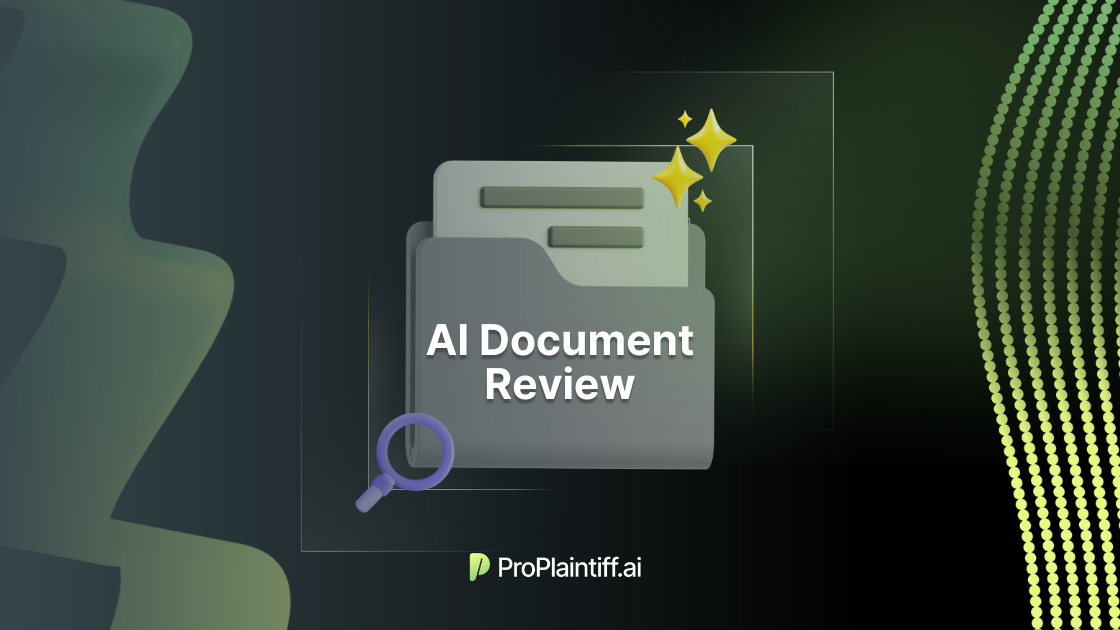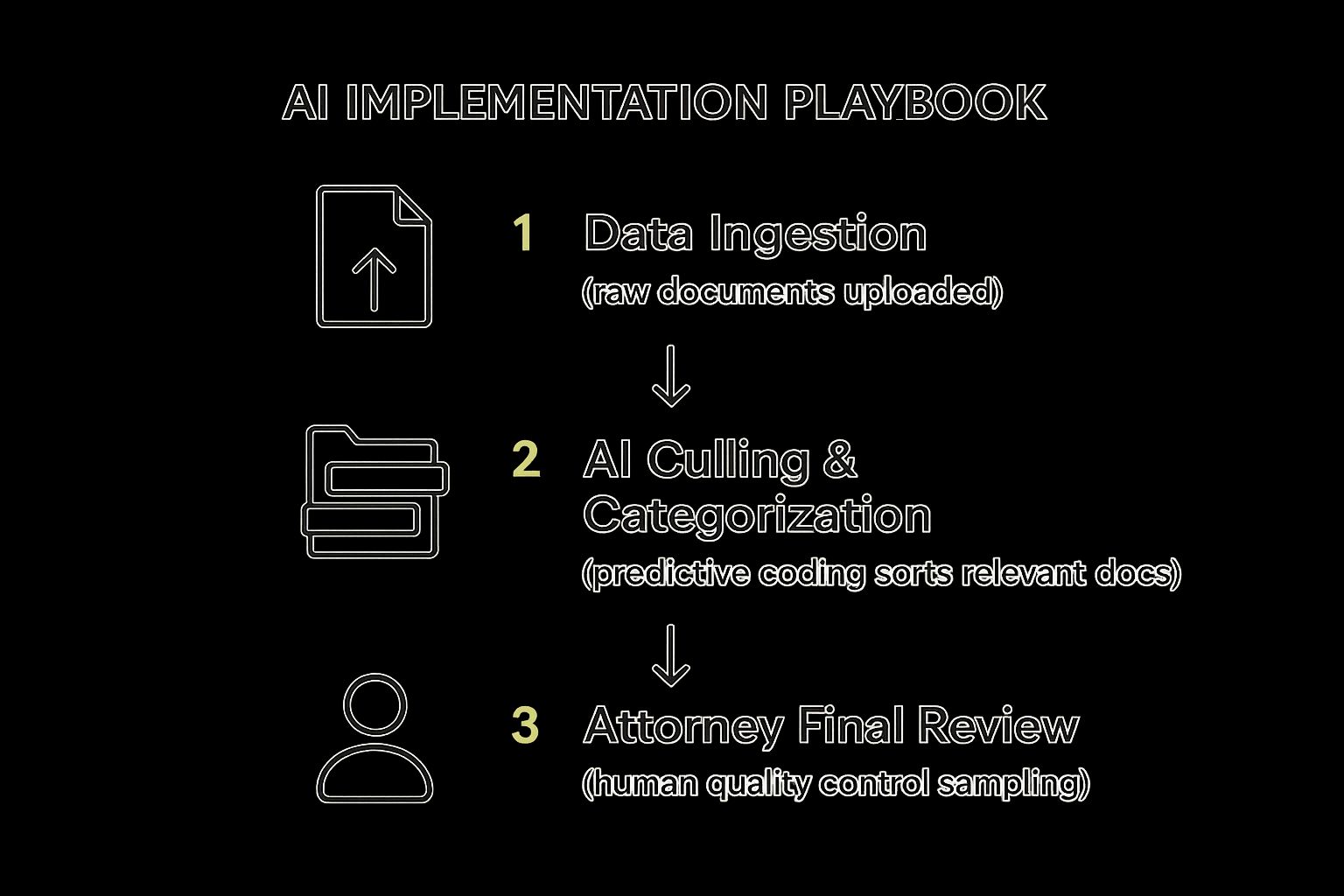Other Blogs
Check out other Legal AI Posts

Discover how AI document review streamlines legal workflows. This guide breaks down the technology, benefits, and practical steps for successful adoption.

AI document review is technology that uses artificial intelligence to automatically find, categorize, and pull key information out of massive piles of legal documents. Think of it like a smart librarian for your case files—one that can read and organize millions of pages in a tiny fraction of the time it would take a human team. For example, in a large-scale product liability case, an AI could analyze millions of internal company emails to identify documents discussing a known defect, a task that would take a human team months to complete.

For decades, the reality of document review for personal injury firms felt like being asked to find one specific sentence by reading every single book in a library. Entire teams of attorneys and paralegals would burn countless hours sifting through mountains of medical records, police reports, and client emails.
The process wasn't just slow and painstaking; it was dangerously prone to human error. With the sheer volume of data in today's cases, that old way of doing things has become completely unsustainable. A study by the American Bar Association found that human reviewers can miss as much as 20% of relevant documents due to fatigue and inconsistency, a margin of error that is unacceptable in high-stakes litigation.
Instead of just having your team read every single page, AI systems can:
Understand Context: AI reads and comprehends the text, identifying concepts, names, dates, and the relationships between them. For instance, it can differentiate between "Dr. Smith," the expert witness, and "Dr. Smith," the client's family physician mentioned in passing.
Organize Information: The system can automatically sort documents based on relevance, privilege, or specific issues you've defined for the case.
Crush Timelines: It shrinks review time from months down to days, giving your team a massive strategic advantage.
This shift from manual labor to intelligent automation is more than just a minor upgrade. It’s an essential transformation for any personal injury practice that wants to stay competitive.
To see the difference in black and white, here's a quick comparison of the old way versus the new. The contrast in speed, cost, and reliability is pretty stark.
Ultimately, the choice becomes clear. While manual review was once the only option, AI now offers a more efficient, affordable, and reliable path forward for firms buried in paperwork.
So, how does this all work? Let's peel back the layers.
Think of it like training a brand-new, incredibly smart legal assistant. You wouldn't just dump a million documents on their desk and expect them to know what’s important. You’d start small.
You’d show them a few examples—this is what a "relevant" medical record looks like, and this is an "irrelevant" one. This first batch of files is what we call training data. The AI studies these examples to learn the specific patterns, language, and context that actually matter to your case.
At the heart of this process is a technology called Natural Language Processing (NLP). This is the magic that allows the software to read and understand human language, much like a person does. It doesn't just scan for keywords. It gets the nuances of legal terms, figures out relationships between people (like doctors and patients), and truly understands the meaning behind a sentence.
For example, NLP can tell the difference between a "prior injury" mentioned in passing and the "new injury" that’s central to the current claim. This ability to grasp context is what makes AI document review so powerful. It's no wonder that a recent survey by the American Bar Association's Legal Technology Resource Center found that 77% of legal professionals now rely on AI tools for exactly this kind of work.
Once the AI has learned from that initial training data, it starts applying what it knows to the rest of the documents. This core function is often called predictive coding or technology-assisted review (TAR).
The AI essentially makes a prediction for every single document, giving it a score based on how likely it is to be relevant. It pushes the most important files to the front of the line for human review, so your team isn't wasting time digging through mountains of junk.
The real magic happens as you work. When a human lawyer reviews a document and corrects the AI’s guess—maybe by marking a flagged email as "not relevant"—the system learns from that feedback. It constantly refines its understanding, getting smarter with every single interaction.
This creates a powerful partnership. The AI handles the overwhelming scale of the data, while human experts provide the critical oversight and legal judgment needed to guide the process.
This back-and-forth learning loop ensures the AI gets progressively smarter and more tuned-in to the specific facts of your case. What starts as a broad sorting process quickly becomes a precision tool for finding the key evidence you need to build a winning argument. You're not just using a program; you're actively teaching an AI to become an expert on your case files.
Beyond just finding individual documents, AI is brilliant at spotting connections and patterns that are almost impossible for a human team to see across thousands of files. The software can connect a seemingly innocent email from one person to a specific event mentioned in a police report, suddenly revealing a relationship or motive that was completely hidden. For instance, in an employment dispute, AI can perform sentiment analysis to identify emails with negative tones between a manager and an employee, creating a timeline of escalating conflict that would be nearly impossible to construct manually.
Getting these insights early gives your firm an incredible head start. By taking over the tedious parts of the review, AI delivers three advantages:
Stronger Case Strategy: You get to build your arguments on a more complete and accurate body of evidence right from the start.
Reduced Risk: A machine-driven analysis is consistent, which means fewer human errors and less inconsistent document coding.
Increased Defensibility: The entire process is transparent and can be repeated, making your discovery methods much harder to challenge.
This shift elevates your firm from simply processing documents to actively pulling intelligence from them. It lets your legal experts spend less time digging and more time thinking, strategizing, and winning.
Bringing an AI document review platform into your law firm isn't like flipping a switch. It’s more like hiring a brilliant, incredibly fast junior associate who needs a bit of training. This playbook breaks down that training process, showing you exactly how your team and the AI work together to build a powerful, efficient workflow.
It all starts with data ingestion. This is simply the process of securely uploading all your raw case files—piles of medical records, police reports, emails, and witness statements—into the AI platform. The system does some initial prep work, getting everything organized and ready for analysis.
Next, the AI gets to work with culling and categorization. Using those predictive coding models we talked about, the software tears through the entire dataset. Its first job is to separate the wheat from the chaff—flagging potentially relevant documents and setting aside the irrelevant ones. This first pass alone dramatically shrinks the mountain of files a human needs to look at.
This is where the magic really happens. The AI’s initial sorting isn’t the final word; it’s just a really good first draft. Now, the process moves into a critical human-led training and quality control phase. An attorney is presented with a small, representative sample of the AI’s decisions. Did it get it right?
When you validate a correct decision or fix a mistake, you're not just correcting a single document. You’re actively teaching the model. Every piece of feedback sharpens the AI's understanding, making its next round of predictions that much smarter. This back-and-forth is the absolute core of a successful AI rollout.
This simple, three-step journey is laid out below.

As you can see, it's all about synergy. The tech provides the speed, while your expert lawyers maintain complete control over the final judgment.
This review cycle continues, with the AI getting progressively smarter and more dialed-in to the unique details of your case. As the model’s accuracy climbs, the need for human correction drops. In fact, reports from industry leaders show that recall rates—the AI’s ability to find what you’re looking for—can hit 90% after just a few of these training loops.
This iterative process is essential for defensibility. It creates a transparent, documented trail showing how the AI was trained and validated, proving the reasonableness of your method.
Finally, the whole process leads to the final attorney review and production. With the document set massively culled and intelligently prioritized, your legal team can focus their valuable time exclusively on the most critical evidence. This final, human-led review ensures nothing slips through the cracks before documents are prepared for production.
For firms trying to figure out which tool is right for them, checking out a guide on the top legal document analysis software can offer a great overview of platforms that excel at this kind of workflow. Ultimately, this playbook is about turning a potentially complex technology into a seamless, integrated part of your firm’s winning strategy.
Bringing AI document review into your firm is about much more than just buying new software. A smooth transition all comes down to careful planning, and that starts with picking the right technology partner.
When you're looking at different vendors, don't get distracted by flashy features. Focus on platforms built specifically for the legal world. These tools will already have the necessary security protocols and compliance frameworks, like HIPAA, baked right in. This single choice is what will protect the security and integrity of your firm's most sensitive data.
Once you’ve selected a vendor, the spotlight turns to your team. Your attorneys and paralegals need to understand not only how to use the tool, but why it works and where it fits into the workflows they already know.
Good training builds confidence. It turns the AI from some intimidating new tech into a reliable assistant that genuinely makes their jobs easier.
A great way to get started is with a pilot project. Pick a single, moderately complex case to test the platform out. For example, a firm could choose a slip-and-fall case with a moderate volume of medical records and incident reports. This controlled environment lets your team learn the ropes on a real-world task and gives you hard data on the return on investment.
A successful pilot project is your best proof of concept. When you can show tangible benefits—like cutting down review hours or finding key facts faster—it becomes much easier to get buy-in from the entire firm for a full-scale rollout.
Data security and ethical use have to be top of mind. The platform you choose must protect client confidentiality with robust encryption and tight access controls. It's also critical to know the difference between a general-purpose AI and specialized legal tech. You can learn more about the AI tools lawyers should avoid for case review to keep your firm and your clients safe.
Finally, your entire process has to be defensible in court. This means keeping a transparent, well-documented record of how the AI was used. Maintain clear documentation of:
Training Data: The specific set of documents used to teach the AI what to look for.
Validation Methods: The quality control steps your team took to check the AI's accuracy.
Performance Metrics: The final accuracy and recall rates the system achieved.
This audit trail gives you the confidence that your discovery process will hold up under scrutiny, protecting the integrity of your work from start to finish.
It’s natural to have questions before bringing any new technology into your firm, especially one as powerful as AI document review. Let’s tackle some of the most common concerns head-on to clarify the practical and ethical side of things.
This is probably the biggest question on every attorney’s mind. The short answer is a firm yes. Courts have widely accepted the use of AI in document review, but with one important condition: the process must be transparent and well-documented. A landmark case, Da Silva Moore v. Publicis Groupe & MSL Group, was one of the first to formally approve the use of technology-assisted review, setting a precedent that has been followed ever since.
Defensibility isn’t about the technology itself. It’s about being able to show a reasonable, managed process for how the AI was trained, validated, and used. As long as you can explain your workflow, you’re on solid ground.
Cost is always a major factor. Pricing for AI platforms can vary, often based on on how much data you process (per-gigabyte) or a monthly subscription. While there’s an upfront investment, the real story is in the total cost of ownership.
When you factor in the massive reduction in billable hours spent on manual review and the ability to turn cases around faster, many firms report overall savings of 50-70%. The return on that investment often shows up surprisingly fast.
With ProPlaintiff.ai converting these incurred expenses into billable work is easy with our law token tracking system. Any law credits used can be converted into a comprehensive invoice to your client, saving you time and money.
Finally, the million-dollar question: is AI coming for our jobs? The answer is a clear no. AI is a tool that enhances legal expertise, not a replacement for it.
Think of it this way: AI is built to handle the high-volume, repetitive work of sifting through thousands of documents. This frees up lawyers and paralegals to focus on what they do best—applying critical judgment, building strategy, and focusing on the most important evidence.
This partnership is the key. The AI does the heavy lifting, and the attorney provides the strategic insight. For a deeper dive into how to implement this responsibly, our guide on the ethics in legal AI use offers essential guidelines. It’s all about making sure technology serves justice without sidelining the crucial role of human legal professionals.
Ready to transform your document review process and free up your team for high-value work? Discover how the AI Paralegal from ProPlaintiff.ai can automate your most time-consuming tasks. Visit ProPlaintiff.ai to get started.
Check out other Legal AI Posts
